Project Log: Sunday, October 16, 2011
I ordered various materials that I wanted on hand to
complete various aspects of the galley, specifically the
stove installation, which I wanted to complete in the
near future, now that the stove was in the boat in more
or less in the way. I ordered a propane hose,
propane control system, and various components for the
fresh water system, all of which would allow me to
proceed with certain installations as dictated by
circumstance or desire.
Now that the countertop was in place, I could continue
with the remaining cabinets above the counter.
Although I'd thought a lot about this, as usual I had no
design or clear direction, all of which would now begin
to coalesce logically in the actual three dimensions of
the space.
My first consideration was the planned wire/hose chase
at the after end. It would have been nice to run
hoses and wiring through the base of the lower cabinets,
but I'd determined earlier that this wasn't feasible
because of existing constraints in the engine room and
tankage spaces. I'd planned to cut holes through
the engine room bulkhead above the galley countertop in
order to run the mechanicals as need be, but discovered
that there was already a large opening at the top of the
bulkhead, in the void created the molded deck bulwark
above. There was more than enough space in this
existing opening for everything I planned to run.
The mechanical chase would require a removable panel on
the front side, facing the galley (outboard of the
refrigerator), including covering the access hole I'd
cut through the countertop for this purpose.
Because of the various existing countertop cutouts and
their juxtapositioning, as well as the countertop vent
over the back end of the refrigerator, I eventually
decided to create a stepped profile to the upper
cabinets, with a small transverse bulkhead at the aft
end of the stove cutout that would close off the space
for the mechanical runs. |
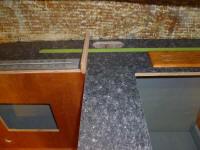 |
Forward of, and including, the stove cutout, I decided
to set the upper cabinet face 1/2" back from the edge of
the stove cutout, running it straight forward behind the
sink. This left adequate clearance for the sink
faucet and worked well in other ways. |
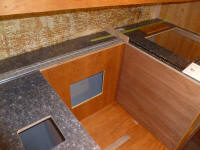 |
This section of the cabinet raised additional questions.
Most original Fisher 30 galleys (including this boat,
when it arrived here) featured built-in plate racks
above the galley, and this sort of plate storage was
something I wanted to incorporate in the new design as
well. This meant that I had to start looking at
some basic dinnerware dimensions, though after looking
at this for a while online I decided I'd prefer to
actually purchase the plates we wanted and have them on
hand for the construction for a custom fit, rather than
building the storage nooks to some random dimension.
I could make better use of the space if I knew exactly
what would be stored there.
This seemed a ridiculous thing to be worrying about now,
but I didn't want storage of these bulky, semi-breakable
items to be an afterthought. My wife and I would
determine what we wanted and order it so that I could
have the items on hand by next weekend, in order to
continue construction of the galley cabinets.
While I wouldn't recreate exactly what had been in place
originally (photo below from August 2010), the basic
idea was sound and worth emulating. |
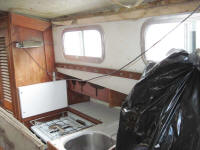 |
In any event, I had enough information and the basic
concept in mind so I could proceed with the bones of the
cabinet construction. To begin, I milled cleat
stock as needed, then installed support cleats for the
new cabinets in the appropriate locations. I used
a long 1" spacer to install the main cleat running from
the stove to the forward bulkhead (which would leave the
finished cabinet face 1/2" from the cutout as intended),
then a short transverse cleat to support the small
bulkhead that returned to the hull at the aft end.
From there, I installed an additional cleat running aft
to support the cover for the wiring chase, plus vertical
cleats on the aft bulkhead. |
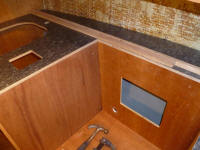
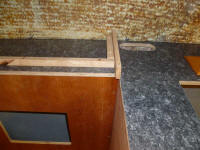
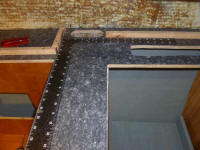 |
Then, I measured, cut, and installed the short bulkhead
defining the aft end of the forward cabinets.
Because I had to wait for the adhesive to cure, I
couldn't really continue with other layout work on the
adjacent cabinets at the moment, which stalled that
particular project. |
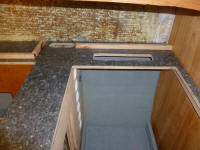
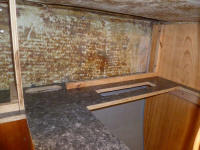
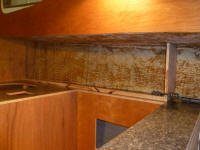
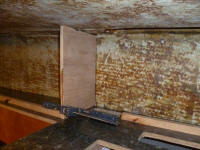 |
To round out the day, I installed a number of wire tie
bases on the hull, preparing for the various
installations that I'd be running through the new wire
chase; I installed these now so I could paint the area
soon, since the adhesive for the bases doesn't work well
on painted surfaces. I'd be running a few things through
the space in the near future, I hoped, at the bare
minimum a propane hose for the stove.
With the goal in mind of installing the stove
permanently, I also milled a short piece of simple trim
to cover the plywood end grain at the front edge of the
stove cutout, where the design of the stove left this
area exposed. Only the centermost portion of the
new trim would be visible when the stove was installed.
Then, I sanded and varnished the back panel of the stove
cutout, as well as the forward section of the
bottom--only those areas that would be exposed (even a
little)when the stove was installed.
At the same time, I varnished the various small parts,
including the galley sink pump recess, cherry louvered
vent units, and the access panel that fit behind the
stove. The other areas of the cabinet already had
some varnish on them, and I saw no reason to varnish the
whole cabinet through all the coats. |
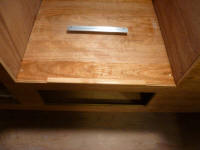
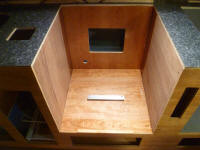 |
It's laying the groundwork that frequently takes the
most time, with the least visible results. This
was one of those days, but these cannot be avoided in
the course of the project.
|
Total Time Today: 5.25 hours
|
<
Previous |
Next > |
|
|













